
Building a 1000 sq ft house requires careful planning and consideration of all the essential materials needed for construction. One of the most crucial elements in building any structure is cement. Cement serves as the binding agent that holds everything together, giving the structure its strength and stability. However, choosing the right type and amount of cement can be overwhelming, especially for those who are not familiar with the construction process. In this article, we will delve into all the important details you need to know about cement for a 1000 sq ft house, from the types of cement available to the amount needed for different parts of the house. Whether you are a homeowner or a contractor, this article will serve as a comprehensive guide to understanding all about cement required for a
How much cement required for 1000 sq ft house

The amount of cement required for a 1000 sq ft house will depend on various factors such as the thickness of the walls and the type of construction method used. However, here is an estimation of the minimum amount of cement needed for a 1000 sq ft house:
1. Foundation: The foundation of a house is the most crucial part of the construction, as it supports the entire structure. The amount of cement required for the foundation will vary depending on the soil conditions and the load-bearing capacity of the site. On average, for a pile foundation, you will need around 100 bags of cement per 1000 sq ft.
2. Walls: The thickness of the walls will also play a significant role in determining the amount of cement required for a 1000 sq ft house. For a load-bearing wall of 8 inches thick, you will need around 140 bags of cement. If the walls are 4 inches thick, you will need approximately 70 bags of cement.
3. Slab: The amount of cement required for the slab will depend on the type of slab used, such as a plain concrete slab or a reinforced concrete slab. On average, you will need around 7-9 bags of cement per 100 sq ft of slab.
4. Plastering: Plastering is done on the interior and exterior walls to provide a smooth finish. For a 1000 sq ft house, you will need around 60 bags of cement for internal plastering and 80 bags for external plastering.
5. Flooring: The amount of cement required for flooring will depend on the type of flooring chosen. For example, for a 1000 sq ft house with a cement concrete flooring of 4 inches, you will need approximately 70 bags of cement.
In conclusion, for a 1000 sq ft house, approximately 500-600 bags of cement (50 kg each) will be required. However, this is just an estimate and may vary depending on the various factors mentioned above. It is advisable to consult a structural engineer to get an accurate calculation of the cement required for your specific project.
Cement bags required for 100 sq ft house
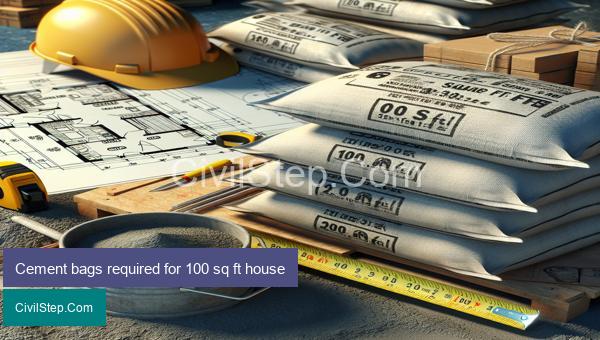
When constructing a 100 sq ft house, one of the most essential materials needed is cement. This versatile and durable material is used in a variety of construction projects, but in the case of a small house, the amount required is relatively small. In this article, we will discuss the approximate number of cement bags required for a 100 sq ft house.
Firstly, it is important to understand that the quantity of cement bags needed for a project depends on several factors such as the type of cement, the thickness of the walls, the area to be covered, and the desired strength of the concrete. For a 100 sq ft house, we will assume a typical 6-inch thick wall, which is commonly used for residential buildings.
Secondly, we need to know the standard size of a cement bag. In the United States, a bag of cement usually weighs 94 lbs or 42.6 kg. The standard size of a cement bag is 1 cubic foot, which is equivalent to 28.3 liters. This means that each bag can cover an area of 1 cubic foot when laid at a thickness of 1 inch.
For a 6-inch thick wall, we need to convert the thickness to feet by dividing it by 12. In this case, 6 inches would be 0.5 feet. Therefore, the area covered by a 94-pound bag of cement for a 6-inch thick wall would be 0.5 cubic feet.
To calculate the number of cement bags required, we need to know the total area of the walls to be constructed. For a 100 sq ft house with 6-inch thick walls, the total area of the walls would be 400 sq ft (100 sq ft for each of the four walls). Therefore, the number of bags required would be 400 sq ft divided by 0.5 sq ft, which is equal to 800 bags.
However, it is worth noting that this calculation does not account for any waste or spillage. It is recommended to add an additional 5-10% to the total number of bags to compensate for this.
Moreover, if a higher strength of concrete is desired, more cement would be needed. For instance, if we want to increase the thickness of the walls to 8 inches, the area covered by one bag would now be 0.67 sq ft. In this case, the number of bags required for a 100 sq ft house would be approximately 600 (400 sq ft divided by 0.67 sq ft).
In conclusion, for a 100 sq ft house with a standard 6-inch wall thickness, approximately 800 bags of cement would be needed. However, it is always advisable to consult with a construction professional to accurately determine the quantity of cement bags required for a specific project.
Cement bags required for 400 sq ft house
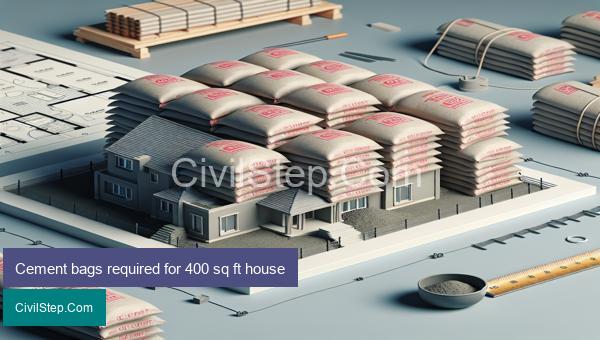
To determine the amount of cement bags required for a 400 sq ft house, we first need to calculate the estimated amount of concrete needed for construction. This can be done by multiplying the length and width of the house in feet (400 sq ft = 20 ft x 20 ft) and then multiplying the result by the thickness of the concrete slab, which is typically 4 inches for residential buildings.
So, the volume of concrete needed for the foundation of a 400 sq ft house would be 20 ft x 20 ft x 4 inches = 1,600 cubic feet. This result needs to be converted to cubic yards, as cement bags are measured in cubic yards. 1 cubic yard is equal to 27 cubic feet, so dividing 1,600 cubic feet by 27 will give us the required volume in cubic yards.
1,600 cubic feet / 27 = 59.26 cubic yards
However, it is recommended to add an extra 5-10% to the estimated amount of concrete for any wastage or spillage during construction. So, for a 400 sq ft house, we would require approximately 63-65 cubic yards of concrete.
Now, we need to account for the amount of cement in this concrete mixture. The general rule of thumb is to use 1 part cement, 2 parts sand, and 3 parts gravel for a concrete mix. This means that for every 6 parts of the mixture, 1 part would be cement.
Therefore, for 63-65 cubic yards of concrete, the amount of cement required would be 63-65/6 = 10.5-11 cubic yards. As 1 cubic yard of cement weighs about 4,000 lbs, this would equal approximately 42,000-44,000 lbs of cement.
The standard weight of a cement bag is 94 lbs. So, dividing 42,000 lbs by 94 lbs, we get 446 bags. Hence, for a 400 sq ft house, approximately 446 cement bags would be required.
However, keep in mind that this is an estimate and may vary depending on the type and strength of cement used, as well as the thickness and design of the concrete slab. It is always best to consult with a structural engineer or a contractor for a more accurate estimation.
Additional factors to consider would be the availability and type of cement in your region, as well as the transportation and labor costs associated with it. It is also important to store the cement bags properly in a dry and well-ventilated area to prevent any potential damage or quality issues.
Cement bags required for 500 sq ft house

In construction, cement is an essential material for building strong and durable structures. As a civil engineer, one of the key tasks is to calculate the amount of cement required for a building project. Let’s take a look at how many cement bags would be needed for a 500 sq ft house.
Firstly, it is important to understand that the amount of cement needed depends on the type of construction, the thickness of the walls, and the design of the house. However, as a general guideline, one can estimate the number of cement bags required per square foot of construction.
For a 500 sq ft house, assuming the standard thickness of the walls to be 6 inches (0.5 ft), the total area to be covered by cement would be 250 sq ft (500 sq ft x 0.5 ft). Generally, a 50 kg bag of cement can cover an area of 35 sq ft when applied at a thickness of 4 inches. Therefore, to cover the 250 sq ft area, approximately 7.14 bags of cement (250 sq ft/35 sq ft) would be required.
However, this is just an estimate and can vary depending on the type of cement used and the thickness of the walls. For example, if the walls are thicker or if the cement used is of lower quality, more bags may be required to cover the same area. This is why it is essential to carefully calculate the amount of cement needed for a specific project.
In addition to the walls, the number of cement bags required will also depend on the other cement-based components of the house, such as the foundation, beams, columns, slabs, and plastering. Each of these elements will require a certain amount of cement, which should be factored in while calculating the total number of bags needed.
Furthermore, it is important to consider some extra bags for any wastage during the construction process, such as spillage, over-mixing, or uneven application. It is recommended to keep an extra 10-15% of cement bags as a buffer to avoid running out in the middle of the project.
In conclusion, for a 500 sq ft house with walls of 6 inches thickness, approximately 7-8 bags (assuming standard quality cement) would be required. However, this number may vary based on several factors, and it is important to calculate the exact requirement for each project to ensure no wastage or shortage of cement. As a civil engineer, it is crucial to accurately estimate the amount of cement required as it directly impacts the strength and stability of the structure being built.
Cement bags required for 600 sq ft house

Cement is an essential building material in construction projects, and it plays a crucial role in providing strength and durability to structures. When constructing a 600 sq ft house, the amount of cement required will depend on various factors such as the type of construction, design of the house, and the thickness of the walls and floors.
On average, a standard cement bag weighs 50kg and covers an area of 1.25 sq ft when applied to a thickness of 1 inch. However, for a 600 sq ft house, we must also consider the wastage of cement during the mixing and application process, which is usually around 5-8%. This wastage is due to spillage, uneven mixing, and material left behind in the equipment.
Therefore, to calculate the number of cement bags required for a 600 sq ft house, we must first determine the thickness of the walls and floors. For a 600 sq ft house, let’s consider the standard thickness of walls to be 6 inches and floors to be 4 inches. So, the total volume of cement required would be:
600 sq ft x 6 inches (wall thickness) = 300 sq ft (convert inches to feet by dividing by 12)
= 300 sq ft x 1/2 ft (thickness in feet) = 150 cubic ft
600 sq ft x 4 inches (floor thickness) = 200 sq ft
= 200 sq ft x 1/3 ft (thickness in feet) = 66.66 cubic ft
Total volume of cement required = 150 cubic ft + 66.66 cubic ft = 216.66 cubic ft
Now, we need to convert this volume into the number of cement bags. Since one cement bag covers an area of 1.25 sq ft when applied to a thickness of 1 inch, a 50kg cement bag contains 1/1.25 = 0.8 cubic ft of cement.
Hence, the number of cement bags required for a 600 sq ft house would be:
216.66 cubic ft / 0.8 cubic ft = 270.82 bags
We can round this off to 271 cement bags with an additional 5-8% for wastage. Therefore, a total of 290-295 cement bags would be needed for a 600 sq ft house.
It is essential to note that this is just an estimate, and the actual requirement may vary depending on factors such as the quality of cement and the efficiency of the mixing and application process.
In conclusion, for a 600 sq ft house requiring 6-inch thick walls and 4-inch thick floors, approximately 290-295 cement bags would be required. It is vital to purchase good quality cement and ensure proper mixing and application for a strong and durable structure.
Cement bags required for 800 sq ft house

Cement is an essential building material that is used in construction projects all around the world. It is a key component in concrete, which is used to create strong and durable structures. As a civil engineer, one of the important tasks is to determine the quantity of cement required for a construction project, such as building a house.
In this scenario, we will discuss the estimated cement bags required for a 800 square foot house. The amount of cement needed for a project depends on various factors such as the size of the project, quality of construction, and type of cement used. To accurately estimate the amount of cement bags needed, we will consider a few assumptions based on common construction practices.
Assuming a 4-inch-thick concrete slab is used for the construction of the house, the total volume of concrete required for the foundation would be approximately 70 cubic feet (800 square feet * 4 inches). This volume includes both the floor and walls of the foundation. However, as per industry standards, the ratio of cement to sand to gravel (aggregate) used in concrete is 1:2:4, which means for every 1 part of cement, we need 2 parts of sand and 4 parts of gravel.
Based on this ratio, for 1 cubic foot of concrete, we need 0.167 cubic feet of cement (1/7). Therefore, for 70 cubic feet of concrete, the total quantity of cement required would be approximately 11.67 cubic feet (70 * 0.167).
Now, one bag of cement typically contains 94 pounds or 1 cubic foot of cement. Hence, the total number of cement bags required for the foundation would be around 11.67 bags (11.67 cubic feet/ 1 cubic foot per bag).
Furthermore, considering the construction of walls, the average thickness of the wall in a house can range from 4-6 inches. Assuming a 5-inch-thick wall, the total volume of concrete required for the walls would be approximately 280 cubic feet (800 square feet * 5 inches).
Following the same calculation method, the total quantity of cement needed for the walls would be around 47 cubic feet (280 * 0.167). This translates to approximately 0.5 bags of cement (47 cubic feet/ 94 pounds per bag).
Adding the amount of cement required for the foundation and walls, the total number of cement bags for a 800 square foot house would be approximately 12 bags. However, it is always recommended to round up the number to compensate for any wastage or unforeseen circumstances on the construction site. Therefore, in this scenario, we can estimate around 15-16 cement bags would be required for the construction of a 800 square foot house.
In conclusion, the amount of cement bags required for a construction project can vary depending on various factors, but with the right calculations and assumptions, an estimate can be made for planning and budgeting purposes. As a civil engineer, it is crucial to carefully determine the quantity of cement needed to avoid any wastage or shortage during the construction process.
Cement bags required for 900 sq ft house

To determine the number of cement bags needed for a 900 sq ft house, we need to first consider the type of construction method, number of floors, and the strength of the concrete mix that will be used.
For a single-story house, the general estimate is that for every 100 square feet, one bag of cement (50 kg) is needed. So for a 900 sq ft house, we will require approximately 9 bags of cement. This estimate is based on a moderate concrete mix with a strength of 1:2:4 (1 part cement, 2 parts sand, and 4 parts gravel).
However, if the construction method involves using concrete blocks, the number of cement bags needed may vary. A typical 8-inch concrete block wall requires approximately 0.37 bags of cement per square foot. So for a 900 sq ft house with walls made of concrete blocks, we will need about 334 bags of cement.
Moreover, for a multi-story building, the amount of cement required will also increase. The addition of each floor will add to the total weight that the foundation needs to support, resulting in an increased need for cement.
It is also essential to consider the type and brand of the cement being used. Different brands have different strengths and requirements, so the amount of cement needed may vary.
Additionally, it is crucial to account for any wastage or spillage that may occur during the construction process. It is recommended to have a small buffer of extra bags of cement to avoid any shortages.
In conclusion, for a 900 sq ft single-story house, 9 bags of cement should be sufficient. For a multi-story or concrete block construction, the number of cement bags needed may increase. It is important to take into consideration the type and strength of the concrete mix being used, as well as any potential wastage, to accurately determine the number of cement bags needed for a 900 sq ft house.
Cement bags required for 1200 sq ft house

Cement is an essential construction material that is used in the building of homes, buildings, and other structures. It is a fine powder made from a combination of limestone, clay, and other materials that hardens when mixed with water. In order to construct a 1200 sq ft house, a certain amount of cement bags will be required for the construction process.
The number of cement bags required for a 1200 sq ft house will depend on several factors such as the type of cement, the strength of the concrete mix, and the construction design. However, as a general estimate, the average amount of cement bags required for a 1200 sq ft house is around 300-400 bags.
To calculate the exact amount of cement bags required, it is important to first determine the volume of concrete needed for the construction. For a 1200 sq ft house, assuming a standard floor to ceiling height of 10 feet, the total volume of concrete required will be 12,000 cubic feet.
Next, the type of cement to be used needs to be considered. Cement bags come in different sizes and weights, with the most commonly used being 50 kg bags. For the purpose of this example, we will consider 50 kg bags of cement.
Now, to calculate the number of cement bags needed, we need to know the ratio of concrete mix used in the construction. The most commonly used ratio is 1:2:4, which means for every one part of cement, two parts of sand and four parts of coarse aggregate are used.
With this ratio, we can estimate that approximately 0.5 cubic feet of cement will be required for every square foot of construction (12,000 cubic feet / 1200 sq ft = 10 cubic feet per square foot). This means that for every 50 kg cement bag, around 1 cubic feet of cement will be produced.
Therefore, for a 1200 sq ft house, approximately 12,000 kg (12 tonnes) of cement will be required (1 kg of cement produces approximately 0.05 cubic feet or 1.4 liters of cement). This amounts to approximately 240-300 bags of cement (assuming 50 kg bags of cement).
However, it is important to keep in mind that this is just an estimate and the actual numbers may vary depending on various factors such as the construction design, type of cement, and strength of the concrete mix used.
In conclusion, a 1200 sq ft house will require an average of 300-400 cement bags for its construction. It is important to accurately calculate the required amount of cement to avoid over or underestimating, which can result in additional costs or delays in construction. It is always advisable to consult a professional engineer or contractor to determine the exact amount of cement bags needed for a specific project.
Cement bags required for 1300 sq ft house
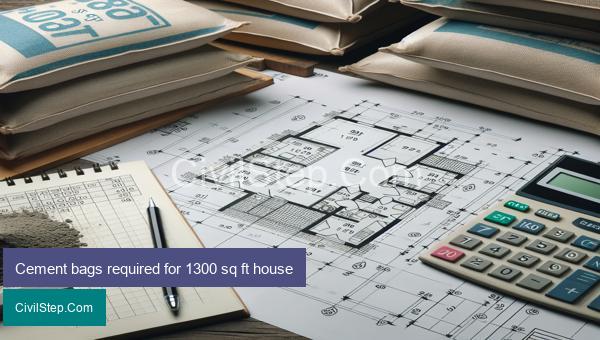
When it comes to constructing a house, one of the most essential building materials is cement. Cement is a binding agent that is used to hold together different materials such as sand, gravel, and water to form a strong and durable structure. In a 1300 sq ft house, the amount of cement required can vary depending on the design, structural requirements, and size of the house.
Typically, cement is sold in the form of bags that weigh 50 kg each. These bags are also known as Portland cement bags. The amount of cement bags required for a 1300 sq ft house will also depend on the type of cement being used, as different types of cement have varying compositions and strengths.
On average, for a 1300 sq ft house, one would require approximately 400 bags of cement. This calculation is based on a standard thickness of 4 inches for walls and 6 inches for the slab. However, this estimation can vary depending on the number of floors, the design of the house, and the number of cement-based structures such as pillars and beams.
For instance, if the house has multiple floors or is built on a sloping terrain, the amount of cement required will increase. Similarly, if the house has more intricate designs and requires more pillars and beams, the amount of cement needed will also be higher.
Factors such as the type of soil, weather conditions, and moisture levels in the environment also play a significant role in determining the amount of cement needed. For example, if the soil is clayey, more cement will be required to ensure a strong foundation.
It is always advisable to consult with a structural engineer or a contractor to get an accurate estimate of the amount of cement required for a specific house project. They will take into consideration all the factors mentioned above and come up with an estimated quantity of cement needed.
In addition to the number of bags, it is also crucial to factor in the cost of cement, which can vary from region to region. It is recommended to buy cement from a reputable supplier to ensure the quality and strength of the cement used in the construction of the house.
To conclude, the exact number of cement bags required for a 1300 sq ft house cannot be accurately determined. However, an estimate of 400 bags of 50 kg each can be used as a reference point. It is always best to consult with a professional and purchase cement from a reliable source for the best results in house construction.
Cement bags required for 1400 sq ft house

As a civil engineer, it is important to understand the materials required for construction projects. When it comes to building a 1400 square foot house, one of the essential materials needed in large quantities is cement. Cement is a vital component in the construction process as it acts as a binding agent, holding together the building materials such as bricks, concrete blocks, and stones.
The number of cement bags required for a 1400 sq ft house will depend on various factors such as the type of cement, construction design, and the building’s location. Typically, the average requirement of cement for construction is 10 to 12 bags per square meter. For a 1400 sq ft house, it would need approximately 140-168 bags of cement.
Factors such as pillars, beams, and slabs also play a significant role in determining the number of cement bags needed. For instance, if your construction design includes more pillars, then you would require more cement to hold them together. Beams and slabs also require a certain amount of cement, so it is essential to factor them in when calculating the total number of cement bags.
Moreover, the type of cement used also affects the quantity needed. There are various types of cement available in the market, such as Ordinary Portland Cement (OPC), Portland Pozzolana Cement (PPC), and Rapid Hardening Cement (RHC). Each type has different compressive strengths and curing times, which would also affect the quantity needed for construction.
The location of your building also plays a role in determining the amount of cement required. If your construction site is located in an area with harsh weather conditions or prone to earthquakes, you may need to use more cement to strengthen the building’s foundation and structure.
It is crucial to accurately calculate the amount of cement needed to avoid any shortage or wastage during construction. You can consult with a structural engineer or a construction expert to determine the exact number of cement bags required for your 1400 sq ft house, based on the above-mentioned factors.
In conclusion, the number of cement bags required for a 1400 sq ft house would range from 140 to 168 bags, depending on the type of cement, construction design, and building location. As a civil engineer, it is essential to ensure the correct amount of cement is used to maintain the structural integrity and durability of the building.
Cement bags required for 1500 sq ft house

To accurately calculate the number of cement bags required for a 1500 sq ft house, we need to determine several factors such as the type of cement, thickness of the walls, and the type of construction.
1. Type of Cement:
The most commonly used cement for house construction is Ordinary Portland Cement (OPC). However, depending on the region and weather conditions, blended cements such as Portland Pozzolana Cement (PPC) or slag-based cement may also be used.
2. Thickness of Walls:
The thickness of walls can vary depending on the type of construction. For instance, load-bearing walls are generally thicker than non-load-bearing walls. The thickness of the walls also depends on the material used for construction, such as bricks or concrete blocks.
3. Type of Construction:
The type of construction also plays a crucial role in determining the quantity of cement required. For instance, a house made of bricks would require more cement than a house made of concrete blocks.
Based on the above factors, let us assume that the house is a basic, load-bearing structure made of bricks and uses OPC cement for construction.
The general rule of thumb for calculating the number of cement bags required for a house is 6-7 bags per 1,000 bricks. However, this estimation can vary depending on the quality and size of the bags and the type of bricks.
Assuming the size of the bricks to be standard (9″x 4.5″x3″), and the cement bags to be of 50 kg each, we can calculate the number of bags required as follows:
Number of bricks in 1500 sq ft = (Area of the house / Area of one brick) = (1500 x 12 x 12) / (9 x 4.5) = 5184 bricks
Number of bags required = (5184 bricks / 1000) x 6 bags = 31.1 bags
Hence, for a basic 1500 sq ft house made of bricks and using OPC cement, approximately 31-32 bags of cement would be required. However, it is always advisable to keep an extra bag or two as a contingency.
In conclusion, it is essential to consider various factors such as type of cement, thickness of walls, and type of construction while calculating the number of cement bags required for a 1500 sq ft house. The estimation may vary depending on these factors and should be checked with a contractor or engineer for accurate calculation.
Cement bags required for 1600 sq ft house

The amount of cement needed for a 1600 sq ft house will depend on various factors such as the design of the house, number of floors, and the type of foundation. However, on average, a house of this size will require approximately 400-500 bags of cement.
Cement is one of the most important construction materials used in building a house. It is a binding agent that is mixed with other materials such as sand, gravel, and water to create concrete, which is used as the primary foundation and structural element of a house.
The number of cement bags needed for a house depends on the ratio of cement to other materials in the concrete mix. The most commonly used ratio for residential construction is 1:2:4, which means one part of cement is mixed with two parts of sand and four parts of gravel. This ratio results in a strong and durable concrete mix that is suitable for building a house.
Based on this ratio, it is estimated that for every 100 square feet of construction, one bag (50 kg) of cement is required. Therefore, for a 1600 sq ft house, 16 bags of cement are needed for one floor. If the house has two floors, a total of 32 bags (16 bags for each floor) will be required.
In addition, additional bags of cement may be needed for the foundation, columns, and beams, depending on the structural design of the house. It is essential to consult with a structural engineer or architect to determine the exact amount of cement required for these elements.
Another factor that may affect the number of cement bags needed is the thickness of the walls. If the walls are thicker, more cement will be needed to create a solid foundation. Moreover, if the house has features such as a basement, pool, or other external structures, additional cement bags may be required.
In conclusion, the amount of cement required for a 1600 sq ft house will be approximately 400-500 bags. However, it is always recommended to seek professional advice to determine the exact amount based on the design and structural requirements of the house. With the right amount of cement and proper construction techniques, your 1600 sq ft house will have a strong and durable foundation.
Cement bags required for 1800 sq ft house

To begin with, it is important to understand that the total number of cement bags required for a 1800 sq ft house will depend on a few factors such as the type of structure, the type of cement used, and the thickness of the walls and floors.
The first thing to determine is the type of structure. For a traditional masonry structure, the number of cement bags required will be different from a structure made with lightweight materials such as precast concrete. We will take a traditional masonry structure as our reference point in this article.
Next, the type of cement used is also crucial in determining the number of cement bags required. Generally, there are three main types of cement used in construction – Ordinary Portland Cement (OPC), Portland Pozzolana Cement (PPC), and Portland Slag Cement (PSC). The quantity of cement bags required will vary depending on the type of cement used. For example, the OPC requires fewer bags compared to PPC or PSC.
Now, let’s look at an estimate for the number of cement bags required for a 1800 sq ft house with a traditional masonry structure and using OPC cement. It is important to note that this is only an estimate and the actual quantity may vary depending on the factors mentioned earlier.
Assuming the walls and floor are 6 inches thick, the total volume of concrete required for the entire structure will be around 3600 cubic feet (1800 sq ft x 0.5 ft = 900 cubic ft for walls + 900 sq ft x 0.5 ft = 900 cubic ft for floor).
Considering that 1 bag of OPC cement (of 50kg) produces around 0.035 cubic meters (1.2 cubic feet) of concrete, we can estimate that approximately 100 bags of cement will be required for the entire structure. However, it is recommended to add an extra 10-15% of cement bags as wastage and for better strength.
Therefore, in total, around 110 to 115 bags of OPC cement may be required for a 1800 sq ft house with a traditional masonry structure.
In conclusion, the number of cement bags required for a 1800 sq ft house will depend on the type of structure, type of cement used, and the thickness of the walls and floors. It is always advisable to consult a structural engineer or contractor for a more accurate estimate.
Cement bags required for 2000 sq ft house

Cement is an essential building material used in construction projects, including building houses. For a 2000 sq ft house, the amount of cement required would depend on the type of construction and the design of the house. Typically, cement comes in bags of 50 kg, and the number of bags required can be calculated based on the amount of cement needed per sq ft of construction.
The following is a general estimate of the number of cement bags required for a 2000 sq ft house:
1. Type of construction: The type of construction plays a crucial role in determining the amount of cement needed. For a conventional RCC (Reinforced Cement Concrete) structure, the amount of cement required would be approximately 0.4 cubic meters (m3) per 100 sq ft of construction. This means that for a 2000 sq ft house, the total amount of cement required would be 0.4 x 20 = 8 m3.
2. Cement bags required: As mentioned earlier, a bag of cement typically weighs 50 kg. Therefore, the number of bags required for 8 m3 of cement would be 8000 kg/50 kg = 160 bags. However, this is the total number of bags required for all the cement work in the house, including the foundation, walls, and plastering.
3. Foundation: The foundation of a house generally requires the most amount of cement. For a 2000 sq ft house, the foundation may require approximately 3-4 m3 of cement. This would translate to 3-4 m3/0.4 m3 per 100 sq ft = 12-16 bags of cement.
4. Walls: For a 2000 sq ft house, the amount of cement needed for the walls would be approximately 2-2.5 m3. This would require 2-2.5 m3/0.4 m3 per 100 sq ft = 8-10 bags of cement.
5. Plastering: The amount of cement required for plastering will depend on the thickness of the plaster. For a 2000 sq ft house, the plastering may require approximately 1.5-2 m3 of cement. This would require 1.5-2 m3/0.4 m3 per 100 sq ft = 6-8 bags of cement.
Note: The above calculation is an estimate based on a conventional RCC structure. The actual amount of cement needed may vary depending on the design and construction method used for the house.
In conclusion, for a 2000 sq ft house, the approximate number of cement bags required would be 160 bags. However, this number may vary depending on the type of construction, foundation design, and other factors. It is always advisable to consult with a structural engineer or a contractor to get an accurate estimate of the cement bags required for a specific project.
Cement bags required for 2100 sq ft house
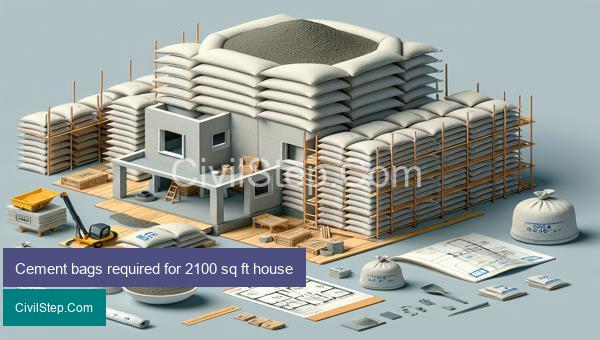
As a civil engineer, one of the key components of any construction project is the cement. Cement is a vital building material that is used to bind other construction materials together, creating a strong and durable structure. So, when it comes to building a 2100 sq ft house, the amount of cement required is an essential factor to consider.
Before we dive into the specific quantity of cement bags needed for a 2100 sq ft house, it is crucial to understand the factors that can affect this quantity. These factors include the type of cement used, the design of the house, and the quality of the soil. These variables can vary from project to project and may influence the quantity of cement needed.
In general, there are two types of cement commonly used in construction – Portland cement and Portland Pozzolana cement (PPC). PPC is a blend of Portland cement and pozzolanic materials, which makes it more economical and environmentally friendly. However, for the purpose of this article, we will assume Portland cement is being used.
Now, let’s look at the estimated quantity of cement bags required for a 2100 sq ft house. A standard cement bag, which is 50 kg, can cover an area of approximately 35 square feet with a thickness of 6 inches. This means that for a 2100 sq ft house with an average thickness of 6 inches, we would need around 1260 square feet of cement.
To calculate the number of cement bags required, we can use the following formula:
Number of cement bags = total area in square feet/coverage area of one cement bag
In this case, the calculation would be:
Number of cement bags = 2100 sq ft/ 35 sq ft per bag = 60 bags
However, it is important to note that this is an estimated quantity, and it may vary depending on the other factors mentioned earlier. It is always recommended to consult with a professional engineer or contractor to get an accurate estimate for your specific project.
Apart from the quantity, it is also essential to consider the quality of the cement. It is crucial to use high-quality cement to ensure the strength and durability of the structure. Low-quality cement may result in cracks and weaken the foundation of the house.
In conclusion, for a 2100 sq ft house, approximately 60 bags of Portland cement would be required. However, this number can vary based on various factors, and it is always best to consult with a professional before making any decisions. Choosing the right quantity and quality of cement is vital for a successful construction project.
Cement bags required for 2200 sq ft house

In the construction industry, cement is one of the most important building materials used for its strength, durability, and versatility. As a civil engineer, it is crucial to accurately estimate the quantity of cement required for a construction project to ensure successful and cost-effective completion.
For a 2200 square feet house, the amount of cement needed will depend on several factors such as the type and thickness of the walls, the number of floors, and the type of foundation used. In general, a 50 kg bag of cement can cover approximately 35 square feet of surface area for plastering and 20 square feet for brickwork, when applied at a thickness of 12mm.
Let us assume that the house will have an average of 10-foot high walls with a thickness of 6 inches and a foundation depth of 3 feet.
For the walls, the total surface area will be 2200 square feet (excluding doors and windows). Therefore, for plastering, the total number of cement bags required will be:
= (2200/35) x 12mm/12 inches
= 63 bags
For brickwork, the total number of cement bags needed will be:
= (2200/20) x 6 inches/12 inches
= 183 bags
Next, let us consider the foundation. The total perimeter of the house will be approximately 200 linear feet (assuming a square-shaped foundation). For a depth of 3 feet, the total volume of concrete needed will be:
= 200 x 3 x 1/12
= 50 cubic feet
One 50 kg bag of cement will approximately produce 0.35 cubic feet of concrete. Thus, the total number of cement bags required for the foundation will be:
= 50/0.35
= 143 bags
Therefore, the total number of cement bags needed for a 2200 square feet house will be:
= Number of bags for walls + Number of bags for foundation
= 63 + 183 + 143
= 389 bags
It is important to note that this is just an estimate and the actual requirement may vary depending on factors such as wastage, quality of workmanship, and the type of cement used. It is always advisable to have a comprehensive project estimation from a qualified civil engineer or architect to ensure accurate calculations.
In conclusion, for a 2200 square feet house, approximately 389 cement bags will be required for the walls and foundation. As a civil engineer, it is essential to have a thorough understanding and estimation of all materials required for a project to ensure a smooth and successful construction process.
Cement bags required for 2400 sq ft house

Cement is a vital component of any construction project, especially in building a house. As a civil engineer, it is important to accurately calculate the amount of cement needed for a project to ensure efficiency and cost-effectiveness. In this article, we will discuss the number of cement bags required for a 2400 sq ft house.
First, it is important to understand the factors that affect the amount of cement needed for a construction project. These factors include the type of cement, the thickness of the walls, the number of floors, and the type of foundations.
The type of cement used for a house construction project is typically Ordinary Portland Cement (OPC). This type of cement is commonly used in residential buildings due to its strength and affordability. OPC is available in different grades, such as 33, 43, and 53. For a 2400 sq ft house, we will assume that a grade of 43 is used, as it is commonly used for residential constructions.
Next, the thickness of the walls is a crucial factor in determining the number of cement bags required. The thicker the walls, the more cement will be needed. For a 2400 sq ft house, we can assume an average wall thickness of 6 inches (0.5 feet).
Moreover, the number of floors is also an important consideration. The more floors a house has, the more walls will need to be constructed, thus requiring more cement. For a 2400 sq ft house, we will consider a single-story construction.
Additionally, the type of foundation also plays a role in the amount of cement needed. Different types of foundations, such as strip foundation, raft foundation, pile foundation, etc., require different amounts of cement. For a 2400 sq ft house, we will assume a strip foundation, which is the most commonly used foundation for residential buildings.
Based on the above assumptions, let us now calculate the number of cement bags required for a 2400 sq ft house.
1. Calculate the total wall area:
Since the thickness of the walls is 6 inches (0.5 feet), we need to double the wall height to get the actual wall thickness i.e., 0.5 x 2 = 1 foot.
Therefore, the total wall area of a 2400 sq ft house is:
2400 sq ft x 4 walls = 9600 sq ft
9600 sq ft x 1 foot = 9600 cubic feet.
2. Convert the total wall area to cubic meters:
Since cement is usually sold in cubic meters, we need to convert the total wall area from cubic feet to cubic meters.
9600 cubic feet x 0.0283 = 271.68 cubic meters.
3. Calculate the volume of cement required:
Based on the grade of cement used (grade 43), the recommended cement-to-sand ratio is 1:2. This means that for every 1 part of cement, 2 parts of sand will be used.
Therefore, the volume of cement required for 271.68 cubic meters of walls is:
271.68 cubic meters/3 = 90.56 cubic meters.
4. Convert the volume to the number of cement bags:
One cubic meter of cement requires 28 bags of cement.
Hence, 90.56 cubic meters x 28 bags = 2536.48 bags of cement.
Therefore, approximately 2536 cement bags will be required for a 2400
Cement bags required for 2500 sq ft house

Constructing a 2500 sq ft house is a significant project that requires careful planning and precise material calculations. As a civil engineer, I understand the importance of using high-quality construction materials, and cement is one of the most crucial components in any building.
Cement is a binding agent that is used to hold together other building materials like sand, gravel, and water to create concrete. It is commonly available in the form of bags and is measured in cubic feet. The amount of cement needed for a 2500 sq ft house will depend on several factors such as the type of cement, the strength of the concrete, and the design of the house. However, I will provide an approximate estimate of the amount of cement bags required based on industry standards.
The first step is to determine the type of cement needed for the project. There are different types of cement available in the market, such as ordinary Portland cement (OPC), Portland Pozzolana cement (PPC), and other specialized blends. The most commonly used cement for residential construction is OPC. It has a strength grade of 53 MPa (mega Pascals) and is suitable for most building purposes. For a 2500 sq ft house, we will need approximately 850 bags of OPC cement.
Next, we need to consider the concrete strength required for the building’s structural elements such as columns, beams, and slabs. The standard concrete mix for residential construction is M20, which has a mix proportion of 1:1.5:3 (cement:sand:aggregate). This mix is suitable for constructing the building’s foundation, walls, and floor slab. Based on this mix proportion, we can estimate that for every 1 cubic foot of concrete, we require 0.0347 bags of cement.
As mentioned earlier, the design of the house can also influence the amount of cement required. For example, if the house has multiple floors, a larger foundation, or uses precast elements, the amount of cement needed may increase. Moreover, experienced contractors may use different concrete mixes for specific structural elements, which can also impact the final cement bag count.
Overall, for a 2500 sq ft house constructed with OPC cement and using a standard concrete mix of M20, we can estimate that approximately 850 bags of cement will be required. However, it is essential to consult with a contractor or structural engineer to get an accurate estimate that considers the specific design and layout of the house.
In conclusion, cement is a vital building material for any construction project, and careful estimation is necessary to ensure the quality and durability of the structure. As a civil engineer, I recommend using high-grade cement from reputable manufacturers to ensure the best results for your 2500 sq ft house construction.
Cement bags required for 3000 sq ft house
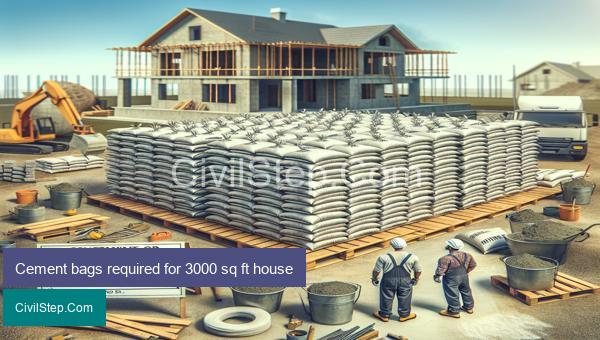
In order to estimate the amount of cement bags required for a 3000 sq ft house, we need to consider a few factors such as the type of foundation and walls, the thickness of walls, and the type of cement used.
Firstly, let us consider the foundation of the house. In most cases, a 3000 sq ft house will have a concrete foundation that is typically 10 inches thick. This would require approximately 150 bags of cement (1 bag = 0.004 cubic meters) for a standard grade of concrete.
Next, we need to consider the walls of the house. If the walls are made of bricks, the average thickness of the wall is 4 inches. For a 10 feet high wall, the total volume of cement required is approximately 178 bags (assuming 8 bricks per square feet and 50% mortar coverage). On the other hand, if the walls are made of concrete, the thickness may vary from 4 inches to 6 inches depending on the structural design. For a 4 inch thick concrete wall, the total volume of cement required is approximately 59 bags, while for a 6 inch thick wall, it would be around 89 bags.
Moreover, if you are planning to build a RCC (reinforced cement concrete) structure, the amount of cement required would be higher. For instance, for a 3000 sq ft house with a 5 inches thick RCC slab, approximately 175 bags of cement would be required. Additionally, the amount of cement needed for plastering, flooring, and other finishings should also be taken into consideration.
Furthermore, the type of cement used also plays a role in determining the number of bags required. For instance, if OPC (Ordinary Portland Cement) is used, the quantity would be less due to its high strength and binding properties. On the other hand, if PPC (Portland Pozzolana Cement) or PSC (Portland Slag Cement) is used, a slightly higher quantity would be required.
In conclusion, for a 3000 sq ft house, approximately 500 to 600 bags of cement may be required, depending on the factors mentioned above. It is always advisable to consult with a structural engineer or a contractor to get a more accurate estimate based on the specific design and materials used for the construction. Additionally, it is recommended to purchase an additional 5-10% of cement bags to account for any wastage or unforeseen circumstances.
Conclusion
In conclusion, cement is a crucial ingredient in the construction of a 1000 sq ft house. It provides strength, durability, and stability to the structure. The amount of cement required for a 1000 sq ft house may vary depending on factors such as the type of construction, design, and location. However, on average, a 1000 sq ft house would require approximately 500 to 700 bags of cement. It is important to ensure that the cement used is of good quality and is mixed properly with other materials to avoid any structural issues in the future. Therefore, it is essential to carefully plan and calculate the required amount of cement for a 1000 sq ft house to ensure a well-built and long-lasting structure.
